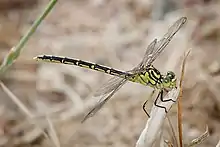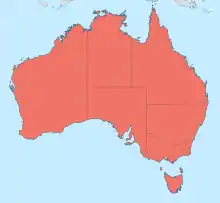Austrogomphus
Austrogomphus is a genus of dragonflies in the family Gomphidae,[3] endemic to Australia.[4] Species of Austrogomphus are tiny to medium-sized dragonflies, black in colour with yellowish markings.[5] They are commonly known as hunters.
| Austrogomphus | |
|---|---|
 | |
| Austrogomphus guerini | |
| Scientific classification | |
| Kingdom: | Animalia |
| Phylum: | Arthropoda |
| Class: | Insecta |
| Order: | Odonata |
| Infraorder: | Anisoptera |
| Family: | Gomphidae |
| Genus: | Austrogomphus Selys, 1854[1][2] |
 | |
Species

The genus Austrogomphus includes the following species in four subgenera:[3][6]
Subgenus Austroepigomphus
- Austrogomphus (Austroepigomphus) praeruptus (Selys, 1857)
Subgenus Austrogomphus
- Austrogomphus angelorum Tillyard, 1913 - Murray River hunter
- Austrogomphus arbustorum Tillyard, 1906 - toothed hunter
- Austrogomphus australis Dale in Selys, 1854 - inland hunter
- Austrogomphus collaris Hagen in Selys, 1854 - western inland hunter
- Austrogomphus cornutus Watson, 1991 - unicorn hunter
- Austrogomphus doddi Tillyard, 1909 - northern river hunter
- Austrogomphus guerini (Rambur, 1842) - yellow-striped hunter
- Austrogomphus mjobergi Sjöstedt, 1917 - pimple-headed hunter
- Austrogomphus mouldsorum Theischinger, 1999 - Kimberley hunter
- Austrogomphus ochraceus (Selys, 1869) - jade hunter
- Austrogomphus pusillus Sjöstedt, 1917 - tiny hunter
Subgenus Pleiogomphus
- Austrogomphus (Pleiogomphus) amphiclitus (Selys, 1873) - pale hunter
- Austrogomphus (Pleiogomphus) bifurcatus Tillyard, 1909 - dark hunter
- Austrogomphus (Pleiogomphus) divaricatus Watson, 1991 - fork hunter
- Austrogomphus (Pleiogomphus) prasinus Tillyard, 1906 - lemon-tipped hunter
Subgenus Xerogomphus
- Austrogomphus (Xerogomphus) gordoni Watson, 1962 - western red hunter
- Austrogomphus (Xerogomphus) turneri Martin, 1901 - flame-tipped hunter
Etymology
The genus name Austrogomphus is derived from two words: the latin word auster meaning south wind, hence south; and the greek word gomphus (γόμφος) meaning peg or nail. It is suggested that the shape of the male tail is generally like that of a bolt used in ship building.[7] Gomphus is also a genus of dragonfly, with some similarities to Austrogomphus, both belonging to the much larger family group, Gomphidae. In 1854 Edmond de Sélys Longchamps named the sub-genus Austrogomphus probably as a southern or Australian component of the gomphid group.[1]
See also
References
| Wikimedia Commons has media related to Austrogomphus. |
| Wikispecies has information related to Austrogomphus. |
- Selys-Longchamps, E. (1854). Monographie des caloptérygines (in French). Brussels and Leipzig: C. Muquardt. p. 430. doi:10.5962/bhl.title.60461 – via Biodiversity Heritage Library.
- Selys-Longchamps, E. (1854). "Synopsis des Gomphines". Bulletin de la Classe des Science, Académie Royale de Belgique (in French). 21 (7): 23–112 [63] – via Biodiversity Heritage Library.
- "Genus Austrogomphus Selys, 1854". Australian Faunal Directory. Australian Biological Resources Study. 2014. Retrieved 13 February 2017.
- Watson, J.A.L.; Theischinger, G.; Abbey, H.M. (1991). The Australian Dragonflies: A Guide to the Identification, Distributions and Habitats of Australian Odonata. Melbourne: CSIRO. ISBN 0643051368.
- Günther Theischinger; John Hawking (2006). The Complete Field Guide to Dragonflies of Australia. CSIRO Publishing. ISBN 0-643-09073-8.
- Martin Schorr; Martin Lindeboom; Dennis Paulson. "World Odonata List". University of Puget Sound. Archived from the original on 28 August 2010. Retrieved 11 August 2010.
- Endersby, I. (2012). "Watson and Theischinger: the etymology of the dragonfly (Insecta: Odonata) names which they published". Journal and Proceedings of the Royal Society of New South Wales. 145 (443 & 444): 34–53 [37]. ISSN 0035-9173 – via Biodiversity Heritage Library.